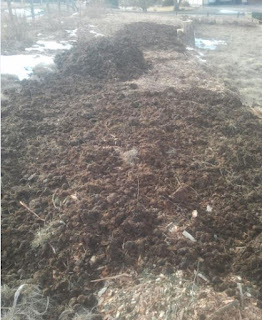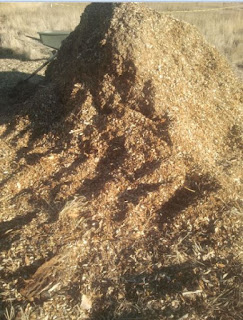Someone asked why do I load and spread that moldy wood chips. They have being composting and decomposing all right. And also I was asked why the heck did I get that dark woody mulch thing wet stuff and spread it around... Yep that was a ground up trees stump.
Why would I need any of that?...
One thing we do not appreciate in the soil when it's tilled is the fact that... you till it it compacts by the end of the season, you til it again and so it goes...
Forest soil does not do that. Why? What's in it that gets killed by tilling?
Whatever it is loves one thing - moist and dark. Do you know one of those living things that like that type of environment?
Right. Fungus and mold.
Learned to hate it right? It's not good in your house it ruins you property and so on. Right, inside you do not want it. Outside in the forest it's however the part of the living systems that has symbiotic relationship with one more thing that likes it moist and dark. What are those? Roots.
So what is there in the forest that forms symbiotic relationship with the roots and soil making it soil?
It turns out one can buy it on amazon and it's the good old nature R&D exists for thousands of years. It is fungus. And it's good for roots. Mycorrhizae.
What is good about it? That's an interesting fungus, makes sort of a clue in the soil
Glomalin is a glycoprotein produced abundantly on hyphae and spores of arbuscular mycorrhizal (AM) fungi in soil and in roots. Glomalin was discovered in 1996 by Sara F. Wright, a scientist at the USDA Agricultural Research Service. The name comes from Glomales, an order of fungi.
So that stuff found and made by nature's R&D is an interesting thing. Here is the link regarding what that does in the lab. Long story short it's the fungus that you want to be in your soil. And one of the ways to get is free is what? Dead trees near roots.,, Your good old forest... Where trees grownicely this fungus grows, get yourself a bucket, get yourself some wood chips, some dirt, Fill your bucket in the forest with good life soil from there, cover the holes you made with material, found around, do not take all, because that living creation of natures R&D needs to live.
It does breed given the environment and it forms symbiotic relationships with the roots. So get some native life soil, bring that home, make fungus bed near your tree, cover it up, keep it reasonably moist, it does not like a lot of water at all. Let it grow, after a bit (3-4 month) it will establish. You can go plant that in your garden. But you do not till that. Because tilling kills it, it brings air, sun and uv and turns soil upside down. May as well go buy yourself next batch on amazon in form of spores someone took from forest (not naive to you). IF you want beneficial fungus, leave your soil be and do not till it.
Also it turns out it acts like sort of a glue in the soil and improves the texture, soil does not compact. And that's what one wants. Let the soil wok for you.
Now we get to weeds. What about them, we hate those and want to kill. And regardless they come back. So what makes weeds stronger. Tried to dig one out? They have heck of a root system... We have all the tools and such to get the roots.
I've mentioned before if one wants to make big changes they need to change how they SEE things. What do you see looking at the weed? The top. Wrong. The weed lives below the surface. Weeds is the roots.
That's the main thing one needs to learn from weeds. They do not buls tops, they build bottoms, that's why they are tough like no one's business.
When one wants stronger plants they want to be there they need to learn from weeds. To make roots. That's why all the landscaping trees in small pots do so bad and do not grow for years and have high failure rate. They all are root bound. When one plants one of those trees it sits there. And has trouble to keep it because it has no root system to support the top.
In the forest that does not happen. Young trees build stem root and lots and lots of side roots.
Same kind of a thing does happen in meadows. Grasses and plants grow root systems, one with the strongest makes it and gets to go to seed.
Do not stick $200 tree into $20 hole. Does not work. Make soil to stick the tree in, put smaller tree in, and oh-oh-oh... I put once a seed from an apple into soil, seeded earth worms and covered with little mulch around. It was under pine tree. Made a decent tree in 2 years, so I transplanted that tree and that was hard to dig it out, so I made a hole, put some peat moss, coffee grounds, compost and good old clay dirt in,, mixed it all, placed worms with coffee grounds at the bottom. In less than 6 years that thing was thick trunk tree and taller than 2 story house... And that's being under typical grass lawn. Now does any of those 3-4-5 year old (no one tells you that $150 tree spent 3-5 years from seed to tree in that tiny pot growing taller than you are... on sale in August) transplanted trees grow in 3 years taller than the 2 story house?
No they do not. They had their root system ripped out.
They will spend a long time rebuilding that, they are sick needing water all the time and build surface roots for 3-4 years. One recalls landscaping company telling you you need to water your trees like every day after planted... How are they going to be forced to go deep to make roots if they get water and nutrients on the surface? How are they going to find fungus to extend that root systems of theirs if there are none?
If something has root system it grows. Like weeds do.
And any landscape tree needs all the help it can get. So cover the dirt, place beneficial fungus and observe your symbiotic relationship...
And if you do not believe me here is the same tree that was poisoned by 2d4d and glyphosate, dying etc.
And by the way that is end of January 2017, our dry season.
Same tree
And same tree in 2014 here
Take a look
See the difference?
And that's June. after April and May, the 2 wettest month around here, first year covered.
Before it was all moved very short weeds here.
It needs more work, but does it look better and still here.
Because yellow large trees do not live, do they?
Big yellow trees make nice income for tree companies
and get brought up here as wood chips.
So I re-fed someone's tree to my tree.
Re-fed crappies mulch no one wanted taken from
swampy boggy area.
Why? It had fungus I wanted, and lots of the spores came here for free.
Do you like the fungus and soil covering now?
Soil particles need to be formed about every 4 weeks. If one does not have symbiotic relationship with the fungus it is not building soil particles for you in there and is not depositing that glue. In other words soil is not working for you instead you are working your tail off at the office or where ever and then buy stuff to put into the dirt... working for dirt.
If soil particles are not held together one has erosion. How fast can we do that? It turns out pretty fast...
So why is that not sold to you by corporations? Cause if you get a little fungus and make soil work for you why the heck would you buy their stuff. I stopped buying it, if you will to that's no good for their business. So one needs to do some footwork and research to find all the nature R&D and thankfully now days there are resources to learn all that stuff benefiting from other folk observations.
Someone already shown you pictures of grass roots that go little down and do not take up water, many times. Can not do that here, do not have water for that. I need my plants and trees to make roots. And I need all the other life forms to help me to do that.
So I'm hiring me a lot of life forms.
Fungus, worms, bugs, spiders, even weeds (cause I soak them, break their cells and feed that liquid back to soil and my plants I want).
The soils are here indeed fertile. They just need to make it out of the dirt state into the soil state.
















































